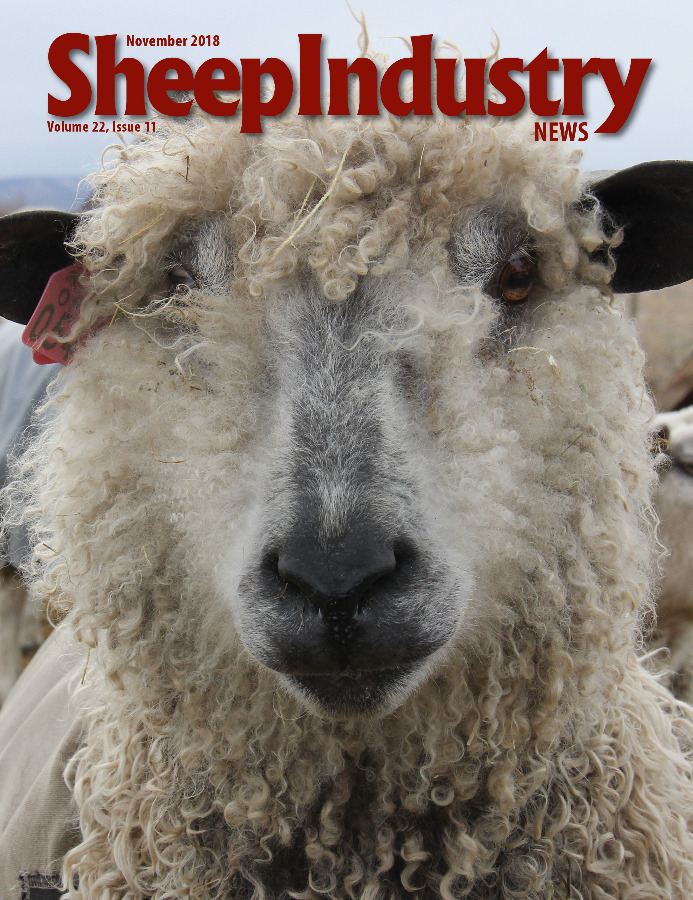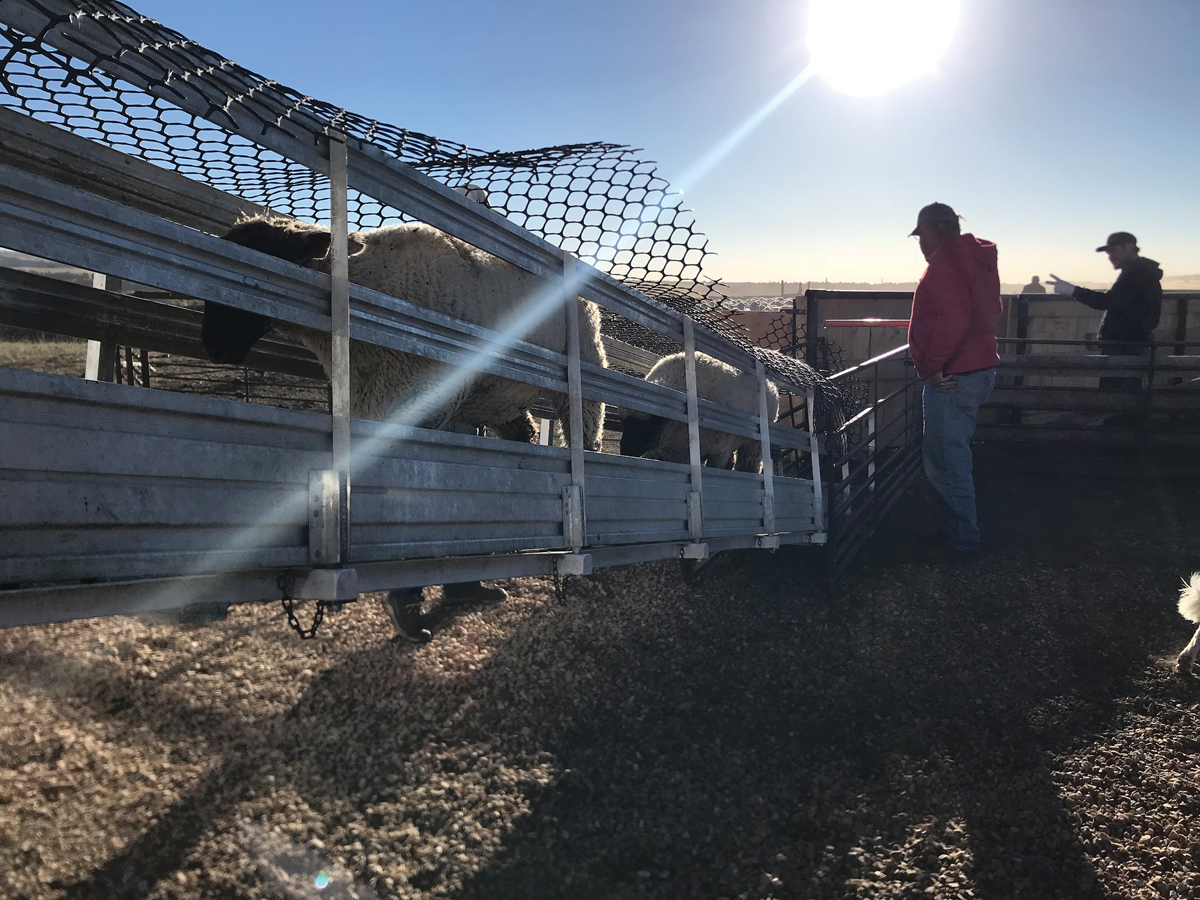
- November 2018
- President’s Notes
- Leading the Way
- ASI Announces Elections
- Lamb Chislic is Official Nosh of S.D.
- Guard Dog Program Supports Legal Defenses
- Raw Material Chronicles Woman’s Wool Industry Journey
- Around the States
- Nominations Open for ASI Awards
- VS Announces Reorganization Plans
- Market Report
- The Last Word
Leading the Way
Let’s Grow Grant Allows Leading Edge Group to Bring Together All Facets of industry
Two years ago, a terminal sire field trial was a resounding success for Utah’s Leading Edge Production Group. Lambs sired by proven rams – as determined by their National Sheep Improvement Program Estimated Breeding Values – weighed an average of three pounds more than those sired by rams without EBVs.
However, the project – funded by an ASI Let’s Grow grant – left some unanswered questions. And that’s why the group was back in Utah in 2017 and 2018. Organizers looked to recreate the trial while eliminating a handful of variables that lingered through the first test. Along the way, the group brought in representatives from each facet of the American sheep industry to create a high-stakes project that just might change the way the industry operates.
 Whether that happens or not, industry insiders need to pay attention to the outcome. Seedstock producers, commercial operators, feedlot owners and packing companies all stand to benefit from the results of this second go-round.
Whether that happens or not, industry insiders need to pay attention to the outcome. Seedstock producers, commercial operators, feedlot owners and packing companies all stand to benefit from the results of this second go-round.
The 2018 lamb crop was shipped to the feedlot in late September, so final results of the trial won’t be available until well after the first of the year when the last load of lambs heads to the processor. In the meantime, take a look at where the project stands today.
The initial trial in 2016 looked to prove that rams with EBVs could produce better than those without. This time around, the group is studying three groups: those with EBVs for high growth, those with EBVs for muscle and industry rams without EBVs.
“Once the lambs have been harvested, we’ll have a total set of production data for every lamb,” Boyer said. “That will give us an analysis of how each of those rams performed. We will be able to distinguish differences between each of those types of rams.”
Trial organizers met at Boyer Land & Livestock in Coalville, Utah, in October 2017 to take blood samples and measurements on blackface, terminal sires from a handful of producers. Those blood tests will help the group track parentage of the lambs as they move through the system. The rams were then turned in with Matt and Dan Mickel’s flock and shed lambed in April. Lambs were tagged, birth data was recorded and tissue samples were collected. They spent the summer in the mountains with the ewes before being weaned in late September and shipped to the feedlot. The final stop will be Superior Farms’ processing plant in Dixon, Calif.
“This was one of those ‘on the back of a napkin’ kind of deals the first time around,” said Ohio producer Bill Shultz, who provided some of the Suffolk rams used in the project. Shultz has also made several trips West to observe the sheep involved. “We learned enough the first time to say that there is a difference and to get people interested. But we knew we could – and should – do more. We hope that what we learn this time around can change the industry. And, there’s probably more follow-up that we can do even after this round.”
A difficult summer left what seemed like half the state of Utah on fire at times, but the flock avoided the problem areas and was ready to be weaned, weighed and shipped in early fall from the Manti-La Sal National Forest outside Ephraim, Utah.
Lamb weights that morning spanned a wide range – which was to be expected. Smaller lambs came in around the 65-pound mark, while a couple of lambs topped the scale at 159.5 pounds.
“There was also a real uniform set of lambs in those middle weights,” Boyer said. “We shipped them all to Forrest Arthur’s feedlot in Idaho. Those big ones might ship out to the processor in late November, while the smaller ones might have to stay on the feedlot until February or March. The majority of them will probably ship out of the feedlot in January sometime.
“They’ve adapted to the feedlot and the rations that Forrest has them on up there,” Boyer said. “A couple of us were up there looking at them in mid-October, and they were doing really well.”
In addition to adding a third group of rams this time around, the group brought in NSIP Technical Committee Chair Ron Lewis, Ph.D., from the University of Nebraska to oversee data collection and analysis.
“He helped us design the whole test to be more scientifically sound,” Boyer said. “By doing that, our results will be more credible. We also have a lot more rams and ewes this time around. The flock we worked with was 1,100 ewes. The rams were more tightly screened, and were all ram lambs this time. All of the data we’re generating was geared toward this program. Hopefully, we’ll have a higher quality set of data to work with when the project is over.”
Boyer said the key number he’ll be looking at isn’t the total average weight for the lambs, but the individual weight of each ram.
“Then we can determine the total impact of using rams with EBVs for some of the different classifications, such as birth weight and weaning weight. We hope this project can start to transform the industry through production.”
The data, Boyer said, could help the group eliminate the bottom 10 percent of the flock.
“Can you imagine the power that would have for the industry as a whole?” Boyer asked. “That’s what we’re trying to figure out. We want to develop management techniques to help every producer get there. That might mean using the electronic identification tags, electronic scales and other technologies that are available to the industry. But we also need to view genetics as one of those technologies that can help us to meet the needs of all facets of the sheep industry.
“If there’s a sector of the industry that wants to see more muscle, or if consumers decide they want to see a bigger loin-eye chop, then we can use these EBVs to head in that direction and provide it. That’s one thing we’re not doing now,” Boyer said. “We need to be taking feedback from the consumer and looking how we can go back to the genetic level to create the carcass traits the consumer wants. But the genetics have to be right, the producer has to be on board, the feeder has to be on board and the processor has to be on board. The whole process has to work together to produce the lamb chop that the consumer really wants in terms of quality, uniformity and the whole works.”

